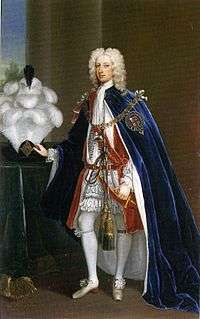John Manners, 3rd Duke of Rutland
| His Grace The Duke of Rutland KG PC | |
|---|---|
|
John Manners, 3rd Duke of Rutland, by Charles Jervis, 1725, Belvoir Castle | |
| Lord-Lieutenant of Leicestershire | |
|
In office 1721–1779 | |
| Monarch | George IV |
| Preceded by | The Duke of Rutland |
| Succeeded by | The Duke of Rutland |
| Personal details | |
| Born | 21 October 1696 |
| Died | 29 May 1779 (aged 82) |
| Nationality | British |
| Political party | Whigs |
| Spouse(s) | Bridget Sutton |
John Manners, 3rd Duke of Rutland KG PC (21 October 1696 – 29 May 1779) was an English nobleman, the eldest son of John Manners, 2nd Duke of Rutland and Catherine Russell. Styled Marquess of Granby from 1711, he succeeded to the title in 1721, cutting short a brief career in the House of Commons, where he had represented Rutland as a Whig.
He held a variety of government and court positions including Lord Lieutenant of Leicestershire 1721–1779, Chancellor of the Duchy of Lancaster 1727–1736, Lord Steward of the Household 1755–1761, and Master of the Horse 1761–1766.
John Manners, the 3rd Duke, was a collector of art. He started buying in 1742 and for two decades bought paintings, drawings and prints at the London art auctions. Agents bought for him at other auctions and he bought privately too, through dealers. On the death of his father, John, the 2nd Duke of Rutland, in 1721, the 3rd Duke had inherited the family collection of paintings acquired by his forebears including Old Masters and an uninterrupted run of ancestral portraits.[1]
He liked small pictures and was reported to have said that “A man did not deserve a good picture that would not carry it home himself”. As a result, he spent less on his collection than other collectors who preferred bigger, more expensive paintings. For example, he did not buy on a par with his grandson, Charles, the 4th Duke of Rutland, friend and patron of Sir Joshua Reynolds. Nevertheless, he was a serious collector whose eye and temperament led him to buy smaller works of all the major European painters including Raphael, Titian, Bassano, Veronese, Guido Reni, and the Italianate northerners, especially Claude and the two Poussins. He is known to have spent some £3,210 for paintings but this figure must be taken as approximate and open to revision if new records come to light. By way of comparison, the building of his London townhouse in the same period, cost some £4,432.[1]
For an unknown reason, the Duke sold 200 paintings in 1758-1759.[1]
In 1717 he married Bridget Sutton, the 17-year-old heiress of Robert Sutton, 2nd Baron Lexinton. They had eleven children, most of whom died young:
- Lady Catherine Rachel Manners (b. 1718), died young
- Lady Caroline Manners (b. spring 1719), died young
- Lady Frances and Lady Bridget Manners (d. 30 December 1719), twins
- John Manners, Marquess of Granby (1721–1770)
- Lord Robert Manners-Sutton (1722–1762)
- Lord George Manners-Sutton (1723–1783)
- Lord William Manners (29 July 1724 – 11 March 1730)
- Lady Leonora Manners (d. June 1740)
- Lady Frances Manners (c. 1726 – 3 February 1739)
- Lord Frederick Manners (b. 17 February 1728)
In 1722 he became a Knight of the Order of the Garter and in 1727 was sworn of the Privy Council. He supported the creation of London's Foundling Hospital and was one of its founding governors when it received its royal charter in 1739.
References
- Descendants of Sir Robert de Manners, of Etal
- Leigh Rayment's Peerage Pages
- Taylor, Carole. "John (Manners), 3rd Duke of Rutland: British art collector". Journal of the History of Collections. Oxford UP. doi:10.1093/jhc/fhw015.
- 1 2 3 Taylor 2016.
| Parliament of Great Britain | ||
|---|---|---|
| Preceded by Lord Finch John Noel |
Member of Parliament for Rutland with Lord Finch 1719–1721 |
Succeeded by Lord Finch Sir Thomas Mackworth, Bt |
| Political offices | ||
| Preceded by The Lord Lechmere |
Chancellor of the Duchy of Lancaster 1727–1736 |
Succeeded by The Earl of Cholmondeley |
| Preceded by The Duke of Marlborough |
Lord Steward 1755–1761 |
Succeeded by The Earl Talbot |
| Preceded by The Earl of Huntingdon |
Master of the Horse 1761–1766 |
Succeeded by The Earl of Hertford |
| Honorary titles | ||
| Preceded by The Duke of Rutland |
Lord Lieutenant of Leicestershire 1721–1779 |
Succeeded by The Duke of Rutland |
| Peerage of England | ||
| Preceded by John Manners |
Duke of Rutland 1721–1779 |
Succeeded by Charles Manners |
